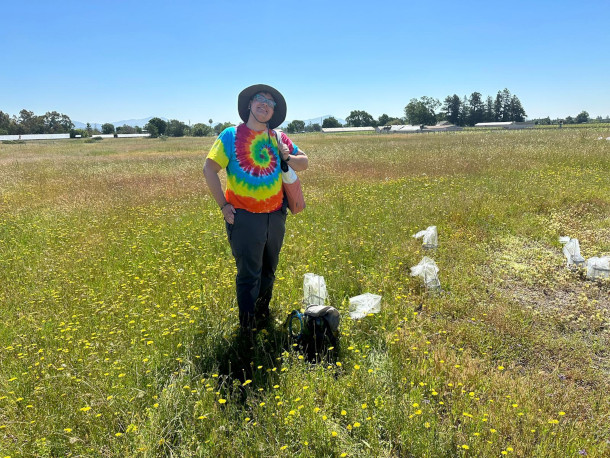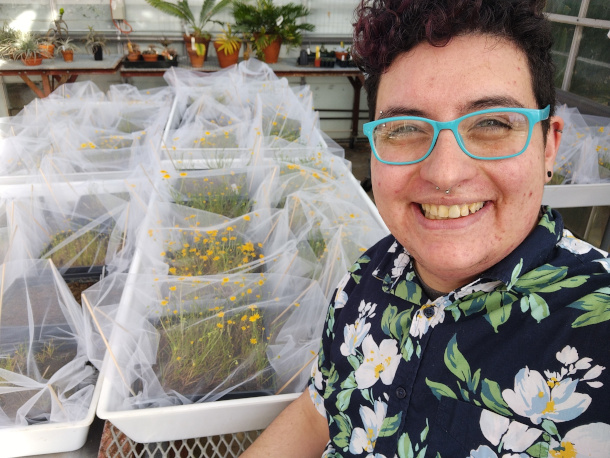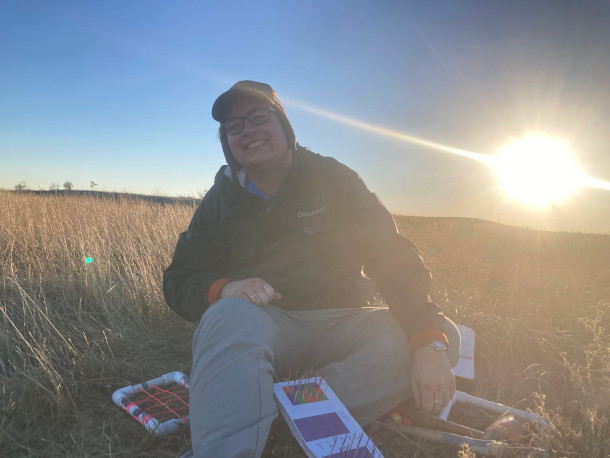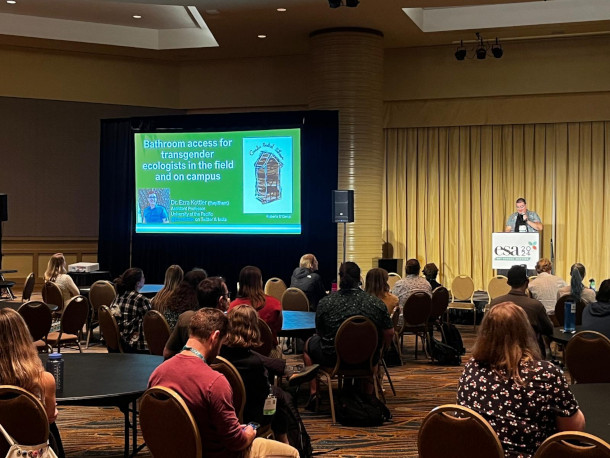Risks for Transgender Field Scientists
Air Date: Week of September 27, 2024

Dr. Kottler works to ensure that the next generation of queer field scientists isn’t deterred by discrimination or lack of infrastructure to support them. (Photo: Nicole Crane, courtesy of Ezra Kottler)
For students and scientists who are transgender or gender nonconforming, field research can bring unique challenges and risks. Dr. Ezra Kottler, a conservation scientist and founder of the Transgender and Gender Nonconforming Field Alliance, joins Host Jenni Doering to describe how institutions can help ensure field research settings are safer and more inclusive of trans people.
Transcript
O’NEILL: It’s Living on Earth, I’m Aynsley O’Neill.
DOERING: And I’m Jenni Doering.
As the academic year kicks into full gear, many fresh-faced college students and their professors are heading out into the field to study ecology, biology, geology and more. But for students and scientists who are transgender or gender nonconforming, field research can bring unique challenges and risks. According to a 2022 study from the Williams Institute at UCLA School of Law around 1.3 million U.S. adults identify as transgender. And as trans people gain recognition and visibility in society, academic institutions are encountering issues of access and inclusion, in the classroom and out in the field. Joining us today to talk about those difficulties and how we can minimize them is Dr. Ezra Kottler, a conservation scientist and founder of the Transgender and Gender Nonconforming Field Alliance. Hi Dr. Kottler and welcome to Living on Earth!
KOTTLER: Hi. Thanks so much for having me. I'm really excited to join you today.
DOERING: So, I understand that you identify as nonbinary. What does that mean to you?
KOTTLER: I'm nonbinary, and that means that I don't identify as a man or as a woman. I also identify as transmasculine, so I generally present masculine of center, but my identity is in this gray area between genders, and that is the case for a lot of trans people.
DOERING: So, you came out during grad school. What were you studying then? And what was that like?
KOTTLER: So, I came out as trans and nonbinary halfway through my PhD in marsh plant ecology, and it was an interesting experience. I was preparing to conduct a research project at a field station for six months of the year, and in order to get out of the way introducing myself with my new name and pronouns to as many of the station crew and scientists as possible, we had an all scientists meeting, and I ended up coming out to my PhD advisor, to my lab and to the research station at that meeting. So, it was a big, scary step into this new era of my life, and there were definitely some people who had a harder time receiving it than others, but overall, I felt like most people wanted to just take it in stride and focus on the science, and I was very happy to do that.

Dr. Ezra Kottler is a Smith Conservation Fellow at University of Colorado, Boulder. They study how plants are responding to the climate crisis. (Photo: Ezra Kottler)
DOERING: Well, what are some of the unique challenges faced by transgender field scientists? Maybe you could walk us through a trip to a field expedition from the perspective of a transgender field scientist.
KOTTLER: So, field scientists do research in remote natural areas all around the world. And so, when field scientists are traveling to a site, they may be getting on an airplane. That will be the first hurdle for a trans field scientist because when you go through TSA and go through the body scanner machine, there is a TSA agent that will look at you and based on a snap judgment of your physical appearance, press a male or a female button that will scan for different body parts based on that assessment. So, if you walk through the machine and there are body parts that weren't expected by the scanning algorithm, you'll be pulled aside for additional screening, which usually involves physical pat down of your body that can feel very scary and invasive for trans people whose bodies don't conform to cisgender norms.
DOERING: Sounds like it adds to what can already be a stressful situation.
KOTTLER: Yes, it definitely does. And so that's the first hurdle. And then when a trans field scientist gets to the region where they're doing their research, this area might have very different laws in place in regards to LGBTQ people than where they live. In many countries, it's still illegal to be gay, and there's very serious legal and safety risks for trans people.
DOERING: Yeah, we've seen a number of so-called bathroom bills popping up in some states across the nation. How do those kinds of laws affect people who are trying to do field research as transgender or nonbinary folks?

The work of field scientists can be in remote, outdoor areas. (Photo: Sarah Newman, courtesy of Ezra Kottler)
KOTTLER: So, the bathroom bills pose major barriers to trans people safely engaging in public life, and that includes in doing field science. For example, in Utah and Florida, using the bathroom that's in alignment with my presentation and my lived experience could be punishable with up to a year in prison. And so, for example, in my research, I work with endangered plant seeds, and once a year I have to drive a bunch of plant seeds from Colorado, where I'm based, to restoration sites in central California. And given the current legal threats to my safety using public bathrooms in the state of Utah, the last time I made this trip, I went to the bathroom in Wyoming before crossing the border into Utah, and then I drove for five hours straight, and then I used the bathroom on the other side of the border in Nevada. And so, you know, there's actually statistics from the US Transgender Survey, which is the largest survey of trans Americans from 2015, that found that 8% of trans people can get a UTI or other form of infection as a result of avoiding bathroom use in places that are unsafe, so it has very real mental and physical health impacts.
DOERING: So, what are some other physical safety considerations for trans scientists working in field settings?
KOTTLER: Some steps that trans people will take to present authentically in their gender and not be seen as gender-nonconforming or identified as trans in a potentially unsafe environment involve compression garments that may put them at higher risk of heat exhaustion. So, transmen and transmasculine nonbinary people may choose to wear a chest binder, which is kind of like a compression sports bra, but specifically designed to help produce a more flat chest appearance for trans men. And that garment can be very important in keeping someone safe and preventing their identity as trans from being revealed, but the compression means that it can be harder to breathe, and in a hot outdoor environment where you're doing heavy physical labor, can mean that you are at a higher risk of heat exhaustion or other heat related illnesses.

Transmasculine people wear a chest binder to make their chest appear flatter. (Photo: Tommas Gunnarsson, Wikimedia Commons, CC BY-SA 4.0)
DOERING: So, what kinds of resources are there for transgender and gender-nonconforming scientists?
KOTTLER: There are a variety of really great affinity groups for queer scientists that are doing community building. One is the International Society of Nonbinary Scientists, which I joined in 2020 during lockdown. And this is a group with over 500 members across the world, across all different disciplines of science, all identifying as nonbinary. And it was really exciting and affirming to join that group and see that I was a part of this larger community of other nonbinary people navigating STEM workplaces.
DOERING: So, you founded the Transgender and Gender-Nonconforming Field Alliance in 2022. How did that organization come about?
KOTTLER: So, I had been doing organizing work with the International Society of Nonbinary Scientists, but one thing that I hadn't seen addressed as much in that organization, because it's broad to all sciences, was issues that specifically affect trans and nonbinary scientists in field settings. So, there are different challenges for scientists working in laboratory environments, but as we've discussed, there are some very specific challenges when you're working in these remote natural areas. And so, I was really inspired by the leadership of the International Society of Nonbinary Scientists who had just launched that organization on Twitter and had it take off. So similarly, I followed the idea of, if something needs to exist and it doesn't exist, then go ahead and create it. And so, I launched the Field Alliance at the 2022 Ecological Society of America meeting. And since then, we've grown to a membership of over 200 trans and nonbinary field scientists. And part of it is definitely about community building, and then part of it is about creating resources to help allies, to help field institutions and field crew leads to make their workplaces safer and more inclusive of trans field scientists.
DOERING: And so, what steps does the Alliance suggest to institutions to make field science more accessible to trans and gender-nonconforming people?
KOTTLER: So, one of the big things is allowing for privacy for trans and gender-nonconforming people, and setting up the infrastructure at field stations to be more gender inclusive. This includes having gender neutral bathrooms where possible and dorm situations where people don't have to choose between a men's dorm and a women's dorm. And my hope and my goal in the organizing work that I'm doing with my awesome colleagues at the Field Alliance is that we can help create some of the necessary infrastructure and preparation so that new LGBTQ scientists, young students coming to get their first field experience, have a safe and a good experience that makes them want to continue in this field, if it's what they're passionate about. And having diverse scientists with different perspectives and lenses of viewing the world makes for a better and stronger science with more revolutionary advances. And so, the goal behind this is that more scientists can see a future for themselves in these career paths and feel like it is safe enough for them to not just survive but thrive in these workplaces.

Trans field scientists can find themselves in locations where they are legally prohibited from using the bathroom that aligns with their identity. (Photo: Melissa Cronin, courtesy of Ezra Kottler)
DOERING: Dr. Ezra Kottler is a conservation scientist and founder of the Transgender and Gender-Nonconforming field Alliance. Thank you so much, Dr. Kottler.
KOTTLER: Thank you so much for having me.
Links
Learn about the Transgender and Gender Nonconforming Fieldwork Alliance
Living on Earth wants to hear from you!
Living on Earth
62 Calef Highway, Suite 212
Lee, NH 03861
Telephone: 617-287-4121
E-mail: comments@loe.org
Newsletter [Click here]
Donate to Living on Earth!
Living on Earth is an independent media program and relies entirely on contributions from listeners and institutions supporting public service. Please donate now to preserve an independent environmental voice.
NewsletterLiving on Earth offers a weekly delivery of the show's rundown to your mailbox. Sign up for our newsletter today!
 Sailors For The Sea: Be the change you want to sea.
Sailors For The Sea: Be the change you want to sea.
 The Grantham Foundation for the Protection of the Environment: Committed to protecting and improving the health of the global environment.
The Grantham Foundation for the Protection of the Environment: Committed to protecting and improving the health of the global environment.
 Contribute to Living on Earth and receive, as our gift to you, an archival print of one of Mark Seth Lender's extraordinary wildlife photographs. Follow the link to see Mark's current collection of photographs.
Contribute to Living on Earth and receive, as our gift to you, an archival print of one of Mark Seth Lender's extraordinary wildlife photographs. Follow the link to see Mark's current collection of photographs.
 Buy a signed copy of Mark Seth Lender's book Smeagull the Seagull & support Living on Earth
Buy a signed copy of Mark Seth Lender's book Smeagull the Seagull & support Living on Earth

